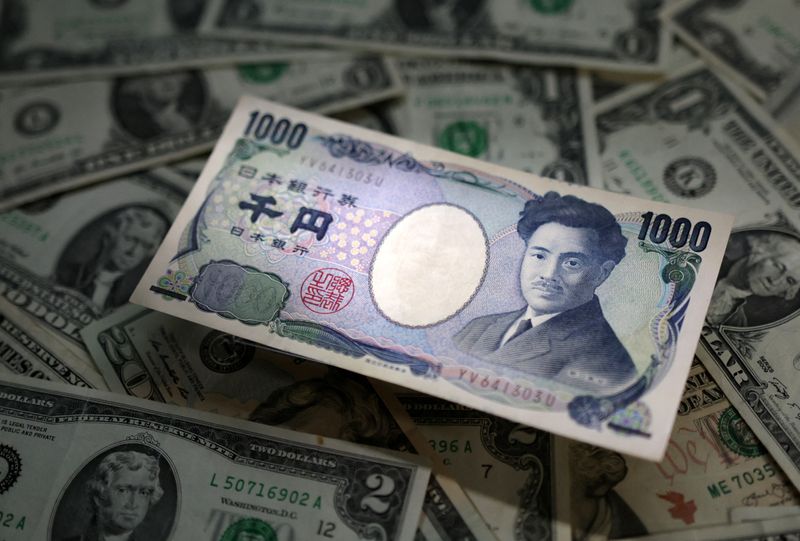Forex
Yen extends losses, euro firms after GDP, inflation data


© Reuters. FILE PHOTO: Japanese Yen and U.S. dollar banknotes are seen in this illustration taken March 10, 2023. REUTERS/Dado Ruvic/Illustration
By Herbert Lash and Alun John
NEW YORK/LONDON (Reuters) -The yen extended losses on Monday from a volatile session at the end of last week after the Bank of Japan (BoJ) loosened its grip on interest rates, but it remained on track for its first monthly gain against the dollar since March.
The dollar was little changed against a basket of major currencies before key U.S. unemployment data at week’s end, while the euro strengthened after data showed economic growth nudged higher and inflation ticked lower.
U.S. non-farm payrolls on Friday will be the first of several data points that will shape a Federal Reserve interest rate decision in late September. Before then, central bank leaders will attend the Fed’s Aug. 24-26 symposium in Jackson Hole, Wyoming, where structural shifts in the global economy will be in focus.
“We’ll have to see if the data from the U.S. continues to paint a resilient picture of the U.S. economy, and if it does, that can help the dollar at least tread water between now and Jackson Hole,” said Joe Manimbo, senior market analyst at Convera in Washington.
The fell 0.03% when measured against six major currencies. But against the yen, the U.S. currency rose 0.74% at 142.200 after fresh intervention by the BoJ on Monday.
The yen went into a tailspin on Friday as traders tried to determine the implications of the BoJ’s move to maintain ultra-low rates while making its bond yield curve control (YCC) policy more flexible and loosening its defense of a long-term rate cap.
The BoJ’s policy of keeping yields pinned down has weighed heavily on the Japanese currency for the past year, and fresh intervention on Monday showed it could continue to do so.
Japan’s benchmark 10-year government bond yield surged to a nine-year high, spurring the central bank to conduct additional purchase operations to slow its rise. The move “has likely surprised some market participants and encouraged yen selling overnight”, MUFG analysts said in a Monday note. [JP/]
Elsewhere in Asia, data on Monday showed China’s manufacturing activity fell for a fourth straight month in July, though the China-exposed Australian dollar and Chinese shares were buoyed by news of further measures to spur the country’s sputtering economic recovery.
The was last up 1.2% at $0.6728, and the slipped 0.02% at 7.1474 per dollar, drawing some support from an announcement from China’s State Council on Monday on measures to restore and expand consumption in the automobile, real estate and services sector.
The dollar was headed for a monthly loss on the prospect that the Fed’s aggressive rate-hike cycle – a key driver of the dollar’s strength – could have come to an end with last week’s 25-basis-point increase.
The dollar is heading for its first monthly loss against the yen since March, and its second successive monthly loss against the euro and pound.
Data on Friday showed that the annual U.S. inflation rate rose in June at its slowest pace in more than two years, with underlying price pressure receding, easing pressure on the Federal Open Market Committee (FOMC) to continue raising rates.
The euro rose 0.23% to $1.104 after data showed euro zone inflation fell further in July, while the bloc returned to growth in the second quarter of 2023 with a greater-than-expected expansion.
The euro is eyeing a monthly gain of about 1%. Last week’s European Central Bank policy meeting raised the possibility of a rate pause in September, though Rabobank analysts said Monday’s data “allow the ECB to both argue for a longer hold as well as for another hike”.
Sterling rose 0.04% at $1.2855, on track for a 1.3% monthly gain, ahead of the Bank of England’s (BoE) policy meeting on Thursday, with market pricing finely balanced between a 25 and 50 basis point increase.
Currency bid prices at 10:29 a.m. (1429 GMT)
Description RIC Last U.S. Close Pct Change YTD Pct High Bid Low Bid
Previous Change
Session
Dollar index 101.5600 101.6100 -0.03% -1.865% +101.8500 +101.5400
Euro/Dollar $1.1040 $1.1015 +0.23% +3.03% +$1.1046 +$1.1006
Dollar/Yen 142.2000 141.1800 +0.75% +8.49% +142.6700 +140.6900
Euro/Yen 157.00 155.48 +0.98% +11.90% +157.2800 +155.1200
Dollar/Swiss 0.8674 0.8709 -0.37% -6.16% +0.8729 +0.8677
Sterling/Dollar $1.2856 $1.2849 +0.06% +6.31% +$1.2872 +$1.2829
Dollar/Canadian 1.3167 1.3252 -0.62% -2.80% +1.3261 +1.3167
Aussie/Dollar $0.6728 $0.6648 +1.20% -1.31% +$0.6728 +$0.6650
Euro/Swiss 0.9577 0.9589 -0.13% -3.21% +0.9623 +0.9577
Euro/Sterling 0.8587 0.8574 +0.15% -2.93% +0.8590 +0.8562
NZ $0.6221 $0.6153 +1.10% -2.04% +$0.6221 +$0.6156
Dollar/Dollar
Dollar/Norway 10.1100 10.2020 -0.82% +3.10% +10.2130 +10.1100
Euro/Norway 11.1641 11.2262 -0.55% +6.39% +11.2520 +11.1491
Dollar/Sweden 10.4959 10.5402 -0.27% +0.84% +10.5595 +10.4767
Euro/Sweden 11.5870 11.6180 -0.27% +3.92% +11.6255 +11.5579

 Forex3 years ago
Forex3 years agoForex Today: the dollar is gaining strength amid gloomy sentiment at the start of the Fed’s week

 Forex3 years ago
Forex3 years agoUnbiased review of Pocket Option broker

 Forex3 years ago
Forex3 years agoDollar to pound sterling exchange rate today: Pound plummeted to its lowest since 1985

 Forex3 years ago
Forex3 years agoHow is the Australian dollar doing today?

 Cryptocurrency3 years ago
Cryptocurrency3 years agoWhat happened in the crypto market – current events today

 World3 years ago
World3 years agoWhy are modern video games an art form?

 Commodities3 years ago
Commodities3 years agoCopper continues to fall in price on expectations of lower demand in China

 Economy3 years ago
Economy3 years agoCrude oil tankers double in price due to EU anti-Russian sanctions





















